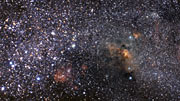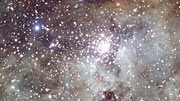Lehdistötiedote
Tähtiä sumuverhon takana
3. helmikuuta 2010
ESO on julkaissut upean VLT-kuvan NGC 3603:a ympäröivästä jättimäisestä tähtien taimitarhasta, jossa syntyy koko ajan uusia tähtiä. Kauniin tähtisumun keskellä sijaitsee eräs Linnunradan kirkkaimmista ja tiheimmistä nuorten, massiivisten tähtien muodostamista tähtijoukoista. Tutkijoille kohde on erinomainen ”lähivastine” muiden galaksien aktiivisille tähtien syntyalueille. Tähtijoukkoon kuuluu myös tähän saakka massiivisin tähti, jonka paino on pystytty laskemaan.
NGC 3603 tunnetaan tähtiryöppyalueena – kosmisena tehtaana, jossa tähtisumun suurista kaasu- ja pölypilvistä syntyy uusia tähtiä kuin sieniä sateella. Alue sijaitsee 22 000 valovuoden päässä Auringosta. Kyseessä on lähin tällainen omasta galaksistamme löydetty kohde. Tähtitieteilijöille alue on mainio paikallinen koeympäristö, jossa voidaan tutkia voimakkaita tähtien syntyprosesseja. Ne ovat muissa galakseissa hyvin yleisiä, mutta yksityiskohdiltaan vaikeasti havaittavissa suuren välimatkan vuoksi.
Tähtisumun muoto johtuu voimakkaista valonsäteistä ja tuulista, jotka tulevat nuorista ja massiivisista tähdistä. Tuulet raottavat kaasu- ja pilviverhoja, joiden takaa paljastuu suuri joukko hehkuvia aurinkoja. NGC 3603:n keskellä olevassa tähtijoukossa on tuhansittain kaikenlaisia tähtiä (eso9946). Suurin osa niistä on massaltaan Auringon luokkaa tai sitä pienempiä, mutta vaikuttavimpia ovat lukuisat hyvin massiiviset tähdet, jotka ovat lähellä kehityskaarensa loppua. Alle kuutiovalovuoden kokoiselle alueelle on ryhmittynyt useita sinisiä superjättiläistähtiä. Joukossa on myös kolme niin kutsuttua Wolfin–Rayetin tähteä. Ne ovat erittäin kirkkaita ja suuria tähtiä, joista sinkoutuu avaruuteen suuria määriä materiaa, ennen kuin ne räjähtävät supernovina tunnettuina jättiräjähdyksinä. ESOn VLT-teleskooppiin (Very Large Telescope) asennetulla SINFONI-instrumentilla saadut havainnot vahvistivat, että yksi tähdistä on noin 120 kertaa Aurinkoa suurempi. Tähti on massiivisin tähän saakka Linnunradasta löydetty [1].
NGC 3603:n pilvet tarjoavat meille perhekuvan kehityskaarensa eri vaiheissa olevista tähdistä. Joukossa on kaasurakenteita, joista parhaillaan muodostuu tähtiä, vastasyntyneitä tähtiä, aikuisia tähtiä sekä tähtiä, jotka jo lähestyvät elinkaarensa loppua. Kaikkien niiden ikä on kuitenkin likipitäen sama: miljoona vuotta. Se on pelkkä silmänräpäys verrattuna viiden miljardin vuoden ikäiseen Aurinkoon ja aurinkokuntaan. Se, että jotkin tähdistä ovat vasta kehityskaarensa alussa, kun taas toiset tekevät jo kuolemaa, johtuu huomattavista eroista tähtien massoissa. Hyvin kirkkaat ja kuumat suurimassaiset tähdet palavat loppuun paljon nopeammin kuin vähemmän massiiviset, himmeämmät ja viileämmät seuralaisensa.
Vastikään julkaistu kuva on otettu Paranal-vuorella Chilessä sijaitsevaan VLT-teleskooppiin liitetyn FORS-instrumentin avulla. Tähtijoukon ympärillä näkyy kuvassa laaja alue, josta erottuu ympäröivien kaasu- ja pölypilvien rikas kudelma.
Lisähuomiot
[1] Tämä nimellä NGC 3603-A1 tunnettu tähti on pimennysmuuttujaksi kutsuttu kaksoistähtijärjestelmä, jonka tähdet kiertävät toistensa ympäri 3,77 vuorokaudessa. Suurempi niistä on arviolta 116 kertaa ja kumppanitähti 89 kertaa Auringon massainen.
Lisätietoa
ESO (European Southern Observatory, Euroopan eteläinen observatorio) on tähtitieteen keskeinen eurooppalainen hallitustenvälinen organisaatio. Se on tuottavuudella mitattuna maailman johtava tähtitieteellinen observatorio. Sen toimintaa tukee 14 maata: Alankomaat, Belgia, Espanja, Iso-Britannia, Italia, Itävalta, Portugali, Ranska, Ruotsi, Saksa, Suomi, Sveitsi, Tanska ja Tšekki. ESO toteuttaa kunnianhimoista ohjelmaa, joka keskittyy tehokkaiden maassa sijaitsevien tutkimusvälineiden kehittämiseen, rakentamiseen ja toimintaan. Välineiden avulla tähtitieteilijät voivat tehdä tärkeitä tieteellisiä havaintoja. ESOlla on myös johtava asema tähtitieteen tutkimuksen ja kansainvälisen yhteistyön edistämisessä. ESOlla on Chilessä kolme huippuluokan observatoriota: La Silla, Paranal ja Chajnantor. ESOlla on Paranalissa VLT-teleskooppi (Very Large Telescope), maailman kehittynein näkyvän valon aallonpituuksia havainnoiva tähtitieteellinen observatorio, sekä VISTA, maailman suurin kartoituskaukoputki. ESO on maailman suurimman tähtitieteen alan projektin, täysin uudenlaisen ALMA-teleskoopin, eurooppalainen yhteistyökumppani. ESO suunnittelee 42-metristä E-ELT-teleskooppia (European Extremely Large optical/near-infrared Telescope, eurooppalainen erittäin suuri optinen/lähi-infrapuna-alueen teleskooppi), josta tulee maailman suurin tähtitaivasta tarkkaileva silmä.
Yhteystiedot
Henri Boffin
ESO
Garching, Germany
Puh.: +49 89 3200 6222
Sähköposti: hboffin@eso.org
Pasi Nurmi (Lehdistön yhteyshenkilö Suomi)
ESO Science Outreach Network
ja University of Turku
Turku, Finland
Puh.: +358 29 4504 358
Sähköposti: eson-finland@eso.org
Tiedotteesta
| Tiedote nr.: | eso1005fi |
| Nimi: | NGC 3603 |
| Tyyppi: | Milky Way : Star : Grouping : Cluster : Open Milky Way : Nebula : Type : Star Formation |
| Facility: | Very Large Telescope |
| Instruments: | FORS1 |
Our use of Cookies
We use cookies that are essential for accessing our websites and using our services. We also use cookies to analyse, measure and improve our websites’ performance, to enable content sharing via social media and to display media content hosted on third-party platforms.
ESO Cookies Policy
The European Organisation for Astronomical Research in the Southern Hemisphere (ESO) is the pre-eminent intergovernmental science and technology organisation in astronomy. It carries out an ambitious programme focused on the design, construction and operation of powerful ground-based observing facilities for astronomy.
This Cookies Policy is intended to provide clarity by outlining the cookies used on the ESO public websites, their functions, the options you have for controlling them, and the ways you can contact us for additional details.
What are cookies?
Cookies are small pieces of data stored on your device by websites you visit. They serve various purposes, such as remembering login credentials and preferences and enhance your browsing experience.
Categories of cookies we use
Essential cookies (always active): These cookies are strictly necessary for the proper functioning of our website. Without these cookies, the website cannot operate correctly, and certain services, such as logging in or accessing secure areas, may not be available; because they are essential for the website’s operation, they cannot be disabled.
Functional Cookies: These cookies enhance your browsing experience by enabling additional features and personalization, such as remembering your preferences and settings. While not strictly necessary for the website to function, they improve usability and convenience; these cookies are only placed if you provide your consent.
Analytics cookies: These cookies collect information about how visitors interact with our website, such as which pages are visited most often and how users navigate the site. This data helps us improve website performance, optimize content, and enhance the user experience; these cookies are only placed if you provide your consent. We use the following analytics cookies.
Matomo Cookies:
This website uses Matomo (formerly Piwik), an open source software which enables the statistical analysis of website visits. Matomo uses cookies (text files) which are saved on your computer and which allow us to analyze how you use our website. The website user information generated by the cookies will only be saved on the servers of our IT Department. We use this information to analyze www.eso.org visits and to prepare reports on website activities. These data will not be disclosed to third parties.
On behalf of ESO, Matomo will use this information for the purpose of evaluating your use of the website, compiling reports on website activity and providing other services relating to website activity and internet usage.
Matomo cookies settings:
Additional Third-party cookies on ESO websites: some of our pages display content from external providers, e.g. YouTube.
Such third-party services are outside of ESO control and may, at any time, change their terms of service, use of cookies, etc.
YouTube: Some videos on the ESO website are embedded from ESO’s official YouTube channel. We have enabled YouTube’s privacy-enhanced mode, meaning that no cookies are set unless the user actively clicks on the video to play it. Additionally, in this mode, YouTube does not store any personally identifiable cookie data for embedded video playbacks. For more details, please refer to YouTube’s embedding videos information page.
Cookies can also be classified based on the following elements.
Regarding the domain, there are:
- First-party cookies, set by the website you are currently visiting. They are stored by the same domain that you are browsing and are used to enhance your experience on that site;
- Third-party cookies, set by a domain other than the one you are currently visiting.
As for their duration, cookies can be:
- Browser-session cookies, which are deleted when the user closes the browser;
- Stored cookies, which stay on the user's device for a predetermined period of time.
How to manage cookies
Cookie settings: You can modify your cookie choices for the ESO webpages at any time by clicking on the link Cookie settings at the bottom of any page.
In your browser: If you wish to delete cookies or instruct your browser to delete or block cookies by default, please visit the help pages of your browser:
Please be aware that if you delete or decline cookies, certain functionalities of our website may be not be available and your browsing experience may be affected.
You can set most browsers to prevent any cookies being placed on your device, but you may then have to manually adjust some preferences every time you visit a site/page. And some services and functionalities may not work properly at all (e.g. profile logging-in, shop check out).
Updates to the ESO Cookies Policy
The ESO Cookies Policy may be subject to future updates, which will be made available on this page.
Additional information
For any queries related to cookies, please contact: pdprATesoDOTorg.
As ESO public webpages are managed by our Department of Communication, your questions will be dealt with the support of the said Department.




